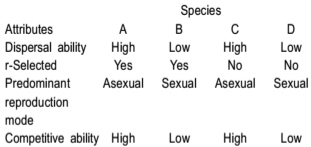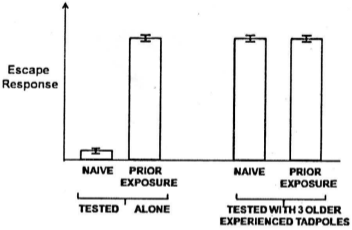 Multiple Choice Questions
Multiple Choice QuestionsFollowing table shows attributes of selected species A, B, C, and D:

Based on the above information, which of the following is most likely to become invasive if climate matches between its site of origin and site of colonization?
Species A and D
Species A only
Species D only
Species B and C
An alphabetical list of tropical rainforest mammals from south America and Africa given below:
| South America | Africa |
| (i) Agouti | (a) Bosman's Potto |
| (ii) Giant Armadillo | (b) Chevrotain |
| (iii) Paca | (c) Pangolin |
| (iv) Three toed sloth | (d) Royal Antelope |
Pair the species in the list to demonstrate the concept of convergent evolution between the two continents
(i)-(d), (ii)-(c), (iii)-(a), (iv)-(b)
(i)-(a), (ii)-(c), (iii)-(d), (iv)-(b)
(i)-(a), (ii)-(b), (iii)-(d), (iv)-(c)
(i)-(d), (ii)-(c), (iii)-(b), (iv)-(a)
A study tested the importance of learning mechanisms in the development of anti-predator escape responses in tadpoles of a frog species. Tadpoles hatched from eggs in the lab were kept individually either with predator chemical cues (PRIOR EXPOSURE) or without predator chemical (NAIVE) for 1 week. These individuals were tested for their escape response when exposed to a live predator. They were tested either alone or together with 3 older experienced tadpoles. The graph below show the escape response of the test individuals in the four different treatments.

Some of the inference drawn are given below:
(a) Prior exposure to predator cues is necessary for the development of escape response.
(b) Prior exposure to predator cues positively influences the development of escape response.
(c) The presence of older experienced individuals is necessary for the development of escape response.
(d) The presence of older experienced individuals positively influences the development of escape response.
(e) An individual with prior exposure and with older and experienced individuals showed the strongest escape response.
Which one of the following combination of statements represents the correct inference from the experiments?
(a) and (c)
(b) and (d)
(a) and (d)
(a), (c) and (e)
Beak shape in birds has evolved in response to their diet. The table listing birds species and food type is given below.
| Bird species | Food Type |
| (a) barn swallow | (i) fruits |
| (b) Great hornbill | (ii) Insects |
| (c) House sparrow | (iii) Nectar |
| (d) Purple sunbird | (iv) Seeds |
Match the bird species shown above to their main food resources.
| (a) | (b) | (c) | (d) |
| (iv) | (i) | (iii) | (ii) |
| (a) | (b) | (c) | (d) |
| (ii) | (iv) | (i) | (iii) |
| (a) | (b) | (c) | (d) |
| (iii) | (ii) | (iv) | (i) |
| (a) | (b) | (c) | (d) |
| (ii) | (i) | (iv) | (iii) |
A population grows according to the logistic growth equation, , where is the rate of population growth, τ is the intrinsic rate increase. N is population size and k is the carrying capacity of the environment. According to this equation population growth rate is maximum at
K/4
K/2
K
2K
Which of the following is the correct increasing order for the daily net primary productivity (NPP) per unit leaf area in different ecosystems?
Deserts < Temperature forests < Tropical forests
Deserts < Tropical forests < Temperature forests
Temperature forests < Tropical forests < Deserts
Tropical forests < Temperature forests < Deserts
A.
Deserts < Temperature forests < Tropical forests
The equilibrium model of island biogeography proposed by MacArthur and Wilson assumes that the number of species on an island represents a blance between
Resource consumption rate and predation rate
Birth rate and death rate
Colonization rate and extinction rate
Specitation rate and hybridization rate
